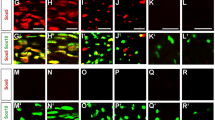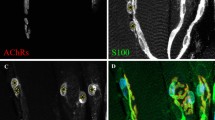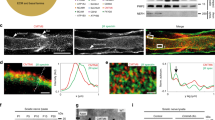Abstract
Neuregulins and their specific receptors, members of the ErbB family of tyrosine kinases, have been implicated in the control of growth and development of Schwann cells1,2,3, specialized cells that wrap around nerve axons to provide electrical insulation. Here we use gene targeting to generate mice that lack ErbB3, a high-affinity neuregulin receptor4,5,6. Homozygous erbB3 mutant embryos lack Schwann-cell precursors and Schwann cells that accompany peripheral axons of sensory and motor neurons. The initial development of motor neurons and sensory neurons of dorsal root ganglia occurs as it should, but at later stages most motor neurons (79%) and sensory neurons in dorsal root ganglia (82%) undergo cell death in erbB3 mutant embryos. Degeneration of the peripheral nervous system in erbB3 mutant pups is thus much more severe than the cell death in mice that lack neurotrophins or neurotrophin receptors7,8. We also show that ErbB3 functions in a cell-autonomous way during the development of Schwann cells, but not in the survival of sensory or motor neurons. Our results indicate that sensory and motor neurons require factors for their survival that are provided by developing Schwann cells.
This is a preview of subscription content, access via your institution
Access options
Subscribe to this journal
Receive 51 print issues and online access
$199.00 per year
only $3.90 per issue
Buy this article
- Purchase on Springer Link
- Instant access to full article PDF
Prices may be subject to local taxes which are calculated during checkout





Similar content being viewed by others
References
Marchionni, M. A. et al. Glial growth factors are alternatively spliced erbB2 ligands expressed in the nervous system. Nature 362, 312–318 (1993).
Dong, Z. et al. Neu differentiation factor is a neuron-glia signal and regulates survival, proliferation, and maturation of rat Schwann cell precursors. Neuron 15, 686–596 (1995).
Zorick, T. S. & Lemke, G. Schwann cell differentiation. Curr. Opin. Cell Biol. 8, 870–876 (1996).
Carraway, K. 3. et al. The erbB3 gene product is a receptor for heregulin. J. Biol. Chem. 269, 14303–14306 (1994).
Sliwkowski, M. X. et al. Coexpression of erbB2 and erbB3 proteins reconstitutes a high affinity receptor for heregulin. J. Biol. Chem. 269, 14661–14665 (1994).
Pinkas-Kramarski, R., Shelly, M., Glathe, S., Ratzkin, B. J. & Yarden, Y. Neu differentiation factor neuregulin isoforms activate distinct receptor combinations. J. Biol. Chem. 271, 190229–19032 (1996).
Lewin, G. R. & Barde, Y. A. Physiology of the neurotrophins. Annu. Rev. Neurosci. 19, 289–317 (1996).
Snider, W. D. Functions of the neurotrophins during nervous system development: what the knockouts are teaching us. Cell 77, 627–628 (1994).
Meyer, D. & Birchmeier, C. Multiple essential functions of neuregulin in development. Nature 378, 386–390 (1995).
Meyer, D. et al. Isoform-specific expression and function of neuregulin. Development (in the press).
Orr, U. A. et al. Neural expression and chromosomal mapping of Neu differentiation factor to 8p12-p21. Proc. Natl Acad. Sci. USA 90, 1867–1871 (1993).
Meyer, D. & Birchmeier, C. Distinct isoforms of neuregulin are expressed in mesenchymal and neuronal cells during mouse development. Proc. Natl Acad. Sci. USA 91, 1064–1068 (1994).
ElShamy, W. M. & Ernfors, P. Alocal action of neurotrophin-3 prevents the death of proliferating sensory neuron precursor cells. Neuron 16, 963–972 (1996).
Lee, K. F. et al. Requirement for neuregulin receptor erbB2 in neural and cardiac development. Nature 378, 394–398 (1995).
Papaioannou, V. & Johnson, R. in Gene Targeting: A Practical Approach (ed. Joyner, A. L.) 107–146 (Oxford Univ. Press, 1993).
Peles, E. et al. Isolation of the neu/HER-2 stimulatory ligand: a 44 kd glycoprotein that induces differentiation of mammary tumor cells. Cell 69, 205–216 (1992).
Holmes, W. E. et al. Identification of heregulin, a specific activator on p185erbB2. Science 256, 1205–1210 (1992).
Yang, Y. et al. Sequential requirement of hepatocyte growth factor and neuregulin in the morphogenesis and differentiation of the mammary gland. J. Cell Biol. 131, 215–226 (1995).
Falls, D. L., Rosen, K. M., Corfas, G., Lane, W. S. & Fischbach, G. D. ARIA, a protein that simulates acetylcholine receptor synthesis, is a member of the neu ligand family. Cell 72, 801–815 (1993).
Sandrock, A. W. et al. Maintenance of acetylcholine receptor number of neuregulins at the neuromuscular junction in vivo . Science 276, 599–603 (1997).
Bunge, R. P. Expanding roles for the Schwann cell: ensheathment, myelination, trophism and regeneration. Curr. Opin. Neurobiol. 3, 805–809 (1993).
Lemke, G. The molecular genetics of myelination: an update. Glia 7, 163–271 (1993).
Kioussi, C. & Gruss, P. Making of a Schwann. Trends Genet. 12, 84–86 (1996).
Griffiths, I. R. Myelin mutants: model systems for the study of normal and abnormal myelination. Bioessays 18, 789–797 (1996).
Barinaga, M. Glimpsing myelin's protein glue. Science 273, 1657–1658 (1996).
Plowman, G. D. et al. Molecular cloning and expression of an additional epidermal growth factor receptor-related gene. Proc. Natl Acad. Sci. USA 87, 4905–4909 (1990).
Yenofsky, R. L., Fine, M. & Pellow, J. W. Amutant neomycin phosphotransferase II gene reduces the resistance of transformants to antibiotic selection pressure. Proc. Natl Acad. Sci. USA 87, 3435–3439 (1990).
Davies, A. M. in Neural Cell Culture: A Practical Approach (eds Cohen, J. & Wilkin, G. P.) 153–176 (Oxford Univ. Press, 1995).
Ockel, M., Lewin, G. R. & Barde, Y. A. In vivo effects of neurotrophin-3 during sensory neurogenesis Development 122, 301–307 (1996).
Kucera, J., Ernfors, P., Walro, J. & Jaenisch, R. Reduction in the number of spinal motor neurons in neurotrophin-3-deficient mice. Neuroscience 69, 321–330 (1995).
Acknowledgements
We thank A. Rehaus for technical assistance; W. Birchmeier and A. Garratt for critical reading of the manuscript; Y. Yarden for human ErbB3 cDNA; M.-M. Portier for the gift of polyclonal anti-peripherin antibodies; R. Mirsky for P0 cDNA; and H. Geldeblom for use of the electron microscope facility. This work was upported by grants from the German Israeli Foundation, the Deutsche Forschungsgemeinschaft, and the BMBF to C.B., and by a grant from the Deutsche Forschungsgemeinschaft to G.R.L.
Author information
Authors and Affiliations
Corresponding author
Rights and permissions
About this article
Cite this article
Riethmacher, D., Sonnenberg-Riethmacher, E., Brinkmann, V. et al. Severe neuropathies in mice with targeted mutations in the ErbB3 receptor. Nature 389, 725–730 (1997). https://doi.org/10.1038/39593
Received:
Accepted:
Issue Date:
DOI: https://doi.org/10.1038/39593
This article is cited by
-
Mature but not developing Schwann cells promote axon regeneration after peripheral nerve injury
npj Regenerative Medicine (2022)
-
Neuromuscular junction-specific genes screening by deep RNA-seq analysis
Cell & Bioscience (2021)
-
PDCD4 limits prooncogenic neuregulin-ErbB signaling
Cellular and Molecular Life Sciences (2021)
-
Extreme Glycemic Fluctuations Debilitate NRG1, ErbB Receptors and Olig1 Function: Association with Regeneration, Cognition and Mood Alterations During Diabetes
Molecular Neurobiology (2021)
-
Neuronal lineages derived from the nerve-associated Schwann cell precursors
Cellular and Molecular Life Sciences (2021)
Comments
By submitting a comment you agree to abide by our Terms and Community Guidelines. If you find something abusive or that does not comply with our terms or guidelines please flag it as inappropriate.



